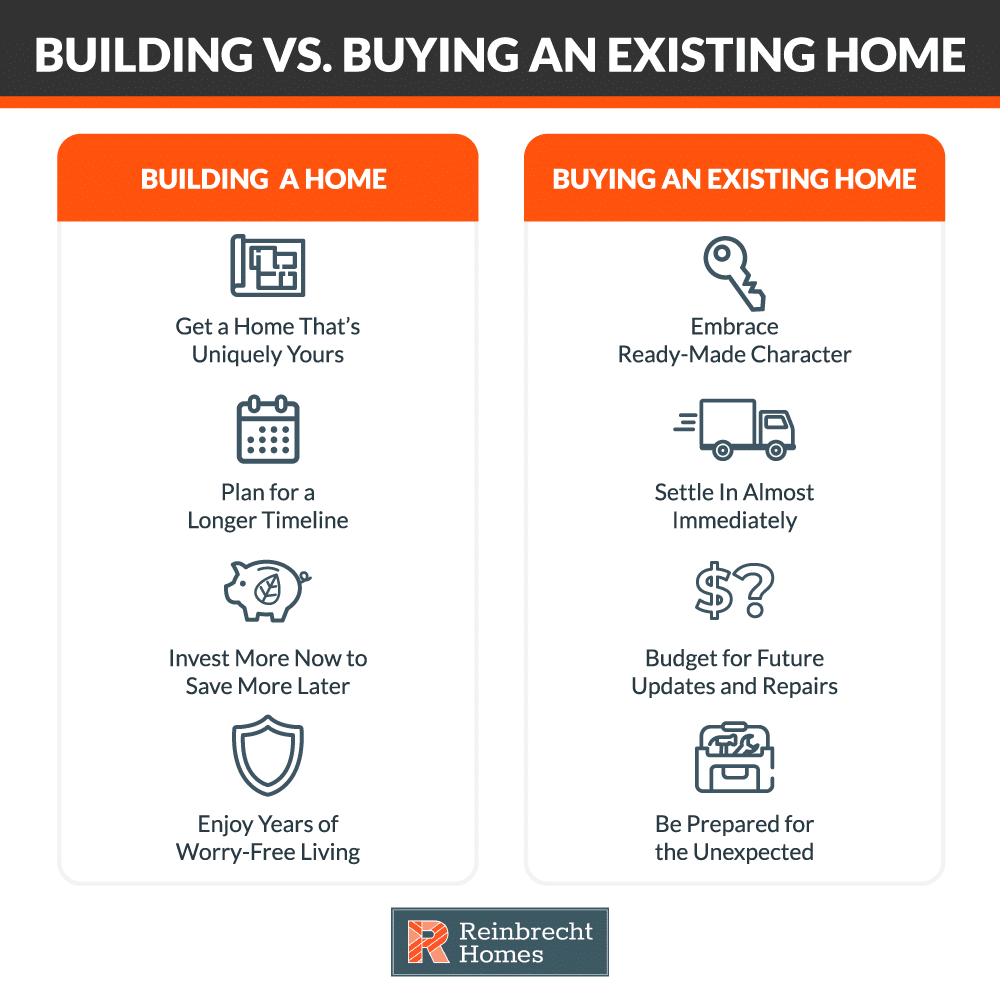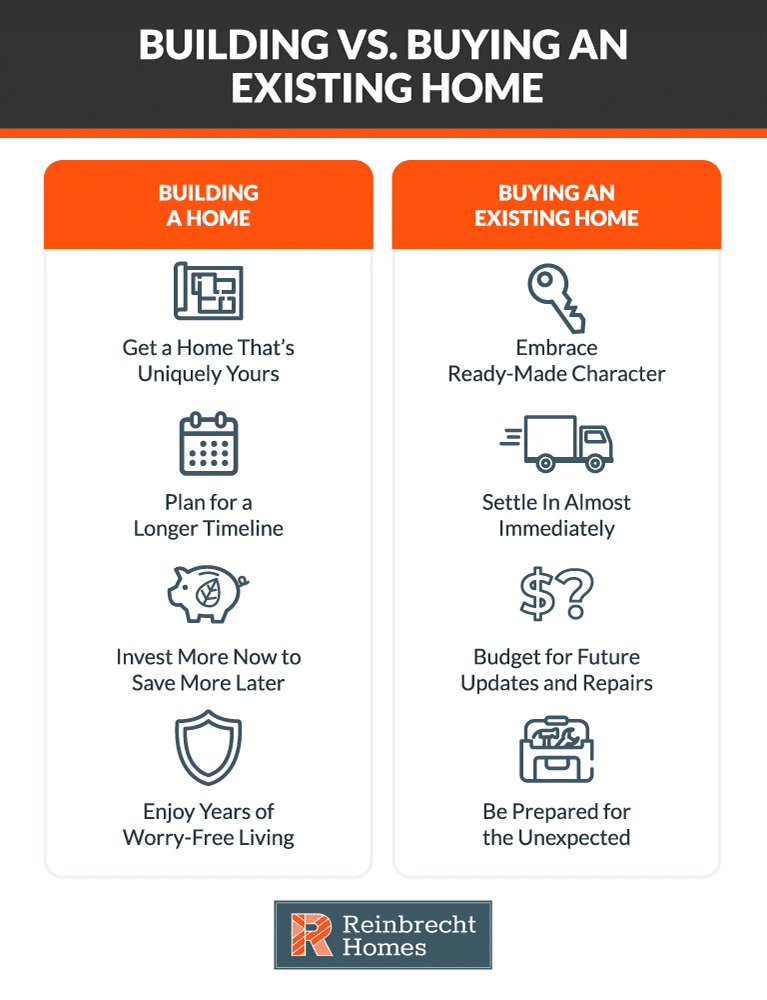Deciding whether to build a new home or purchase an existing one is a milestone that can shape your future, especially in the dynamic market of Southern Indiana and Eastern Illinois. This choice often comes down to balancing the creative freedom of a custom-built home with the convenience of an existing property.
However, a popular third option—the semi-custom home—offers a compelling blend of both, providing personalization without the pressure of a fully custom design. To help you choose the best path, this guide offers clear insights into all three options—budget, timeline, customization, and lifestyle goals—empowering you to make an informed decision aligned with your vision for the future.
Advantages of Building a Home
Building your home allows you to turn your vision into reality. The key benefits include:
Personalized Customization
Begin with the freedom to design every detail:
- Choose every aspect—from floor plans and finishes to special features like a home office or playroom.
- Select materials and fixtures that perfectly match your style.
- Create a functional space that adapts with your lifestyle.
Energy Efficiency and Sustainability
Modern builds can significantly lower your long-term costs:
- Incorporate high-performance insulation and efficient windows designed to keep energy use in check.
- Enjoy lower energy bills and improved indoor comfort.
- Support sustainable living with eco-friendly building practices.
New Systems, Warranties, and Peace of Mind
New construction provides reliability:
- Benefit from new systems that rarely require immediate repairs.
- Rely on builder-backed warranties covering major elements.
- Experience fewer surprises and enjoy long-term cost savings on maintenance.
Transparent and Flexible Financing
Financing your build can be straightforward:
- Utilize specialized construction loans and options designed to make homeownership more accessible.
- Benefit from clear cost estimates and the ability to adjust design elements to balance quality with affordability.
- Leverage transparent financing options available in the market for added peace of mind.
Visibility and Control During Construction
Stay closely involved throughout the process:
- Use real-time project management tools to monitor progress and approvals.
- Enjoy the satisfaction of watching your home evolve exactly as you envision it.
Strategic Locations in New Communities
Choose a location that aligns with your lifestyle:
- Build in emerging neighborhoods designed for modern living.
- Enjoy amenities such as parks, green spaces, and planned community features.
- Benefit from strong infrastructure and, in many cases, access to excellent local schools that help solidify community value.
Drawbacks of Building a Home
While building offers unmatched customization, it also comes with challenges:
Extended Timelines
- Construction typically takes longer than buying an existing home.
- Delays can occur due to weather, permit issues, or material availability.
- Flexibility with temporary living arrangements may be necessary.
Higher Upfront Costs
- Initial costs tend to be higher because of construction materials, permits, and design upgrades.
- Unexpected expenses, such as site preparation or utility connections, may arise.
- Careful budget planning and understanding financing options are crucial.
Decision Overload
- With many design choices comes the possibility of feeling overwhelmed.
- The numerous decisions—from architectural details to finishes—can lead to decision fatigue.
- Streamlining choices with expert guidance can help manage these challenges.
Benefits of Buying an Existing Home
Buying a pre-owned home also offers strong advantages:
Immediate Availability
- Move into your new home without the delay inherent in construction.
- This option works well for those facing time-sensitive needs like job relocations or family commitments.
Potential for Cost Savings
- Often, an existing home requires a lower initial investment.
- Many resale properties need only minor cosmetic updates, preserving affordability while ensuring comfort.
Established Charm and Character
- Enjoy unique architectural features, mature landscaping, and storied character.
- Experience the warmth and personality of homes that have stood the test of time.
- Benefit from established neighborhoods featuring distinctive architectural features and mature landscaping.
Developed Neighborhoods and Amenities
- Established areas come with mature infrastructure, including reputable schools, parks, and local services.
- Enjoy a sense of community that comes with long-standing neighborhoods.
- Benefit from the stability and convenience that established areas provide.
Drawbacks of Buying an Existing Home
Consider these potential challenges before purchasing:
Limited Customization
- Existing homes come with fixed layouts and finishes that may not suit your vision.
- Renovating for personalization can be both disruptive and costly.
- You might have to compromise on certain design features.
Higher Maintenance Costs
- Older homes might need ongoing repairs or updates.
- Aging systems such as roofs, plumbing, or electrical can lead to unpredictable expenses.
- Hidden issues may surface even with thorough pre-sale inspections.
Outdated Features and Efficiency
- Many older homes lack modern energy-efficient systems.
- Upgrading insulation or windows to modern standards can be expensive.
- Higher utility bills might offset initial savings over time.
Absence of Warranty Protection
- Most resale properties do not offer the warranties that come with new construction.
- This exposes you to greater financial risk from unexpected repairs.
- The absence of warranty coverage can lead to higher long-term expenses.


Finding the Middle Ground: The Semi-Custom Home Option

For many homebuyers, the choice isn’t a simple “either/or.” They want the reliability and personalization of a new build without the stress of a fully custom project, and the convenience of a proven design without the maintenance risks of an older home. This is where the semi-custom home emerges as an ideal solution, offering the best of both worlds.
A semi-custom home begins with a portfolio of professionally designed, builder-vetted floor plans. This immediately solves one of the biggest drawbacks of building: decision overload. Instead of starting with a blank page, you begin with a layout that is already optimized for flow, functionality, and cost-efficiency.
From there, the personalization begins. You work with the builder to select all the key elements that make a house feel like a home. This includes choosing your own:
- Interior and exterior finishes, from siding and stone to flooring, paint colors, and trim.
- Kitchen and bathroom fixtures, cabinets, and countertops.
- Lighting packages and appliance selections.
- Optional structural modifications, such as adding a three-car garage, finishing a basement, or moving non-load-bearing walls.
By choosing a semi-custom path, you get the peace of mind that comes with all-new systems, modern energy efficiency, and a comprehensive builder’s warranty. At the same time, you get to infuse the space with your unique style, creating a personalized home without the overwhelming pressure and higher costs of a fully custom architectural design.
How to Make Your Choice: A Practical Guide
With a clear understanding of the pros and cons, you can move forward with a practical plan. Follow these steps to determine whether building or buying is the right path for your future.
1. Evaluate Your Financials and Long-Term Investment
Start with a comprehensive look at your budget and financing options, from conventional mortgages to specialized construction loans. Go beyond the initial price tag and perform a comparative cost analysis over time. While building may have a higher upfront investment, it often leads to significant long-term savings through reduced energy consumption and minimal maintenance costs, thanks to modern efficiencies and comprehensive warranties. You may even be eligible for incentives or tax credits for green building practices.
Conversely, an existing home may require expensive updates to its roof, plumbing, or HVAC systems that should be factored into your financial planning. Also, consider property appreciation. A custom-built home in a developing neighborhood can see significant value growth as the area matures, while a home in an established, historical area may have a unique appeal that retains its value due to sought-after character and community heritage.
2. Clarify Your Priorities and Vision
Create a detailed list of “must-haves” versus “nice-to-haves.” How important is total personalization? If you have a specific vision for your floor plan, finishes, and features, a fully custom build is the only way to achieve it without compromise. However, if you find yourself somewhere in the middle—wanting the assurance of a new build and significant personalization, but feeling overwhelmed by a blank-page process—the semi-custom path may be your ideal solution. Next, weigh your desire for location and community. Do you prefer the mature trees, established schools, and unique charm of an older neighborhood, or the modern amenities, planned green spaces, and fresh infrastructure of a new development?
Beyond the tangible features, consider the post-purchase experience. Many homeowners find deep satisfaction in the journey of building, watching their unique vision materialize from the ground up and celebrating milestones along the way. This personal touch can be a rewarding and memorable part of creating a home that is a perfect fit for years to come.
3. Assess Your Lifestyle and Timeline
Be realistic about your urgency. If you have a time-sensitive need to move for a job or family commitment, the immediate availability of an existing home is a clear advantage. Building a home is a longer process—often 6 to 12 months or more—and can be subject to delays from weather, permits, or material shortages. Ensure you have the flexibility in your living situation and the patience required to accommodate a construction timeline.
4. Conduct On-the-Ground Research and Consultation
Theory only goes so far. Engage with industry professionals like experienced homebuilders and real estate agents who understand the local market. Their expertise is invaluable for clarifying construction costs, navigating market trends, and understanding the local building codes or zoning laws that will impact what you can build on a specific piece of land. Then, get a feel for both options firsthand. Tour model homes in new communities to visualize layouts and quality craftsmanship. Simultaneously, visit existing homes for sale to see what your budget can get you right now. This direct comparison is often the most clarifying step in the entire process.
Making the Right Choice: Your Path to Homeownership

Choosing your path to homeownership is a deeply personal decision that depends on your financial situation, timeline, and design preferences. A fully custom build offers the ultimate in personalization and modern efficiency. In contrast, buying an existing home provides immediate comfort and the charm of established neighborhoods. For many, the semi-custom option presents the perfect balance, delivering a personalized, brand-new home without the pressures of a fully custom project.
By carefully considering the implications of all three paths, you can make a decision that not only meets your present needs but also secures a valuable investment for the future. Don’t wait to transform your vision into reality. Contact Reinbrecht Homes today to explore your homebuilding options. With over 25 years of experience in crafting custom and semi-custom homes, they are prepared to guide you through every stage of the process. Whether you choose to build or buy, your perfect home awaits.

